Global Maximum Power Point Tracking of Photovoltaic Module Arrays Based on Improved Cuckoo Search Algorithm
Abstract
:1. Introduction
2. Failure and Shading Characteristics of Photovoltaic Module Arrays
- Step 1.
- Set the number of nests to n, the discovered probability to Pa, the number of iterations to T, and the step factor to β.
- Step 2.
- Generate new solutions of the number of bird nests n by applying Equation (1) of the Le’vy flight random-walk formula, and obtain the best and worst new solutions, and , respectively, among all numbers of bird nests by comparison.where and represent the position of the ith bird nest in the tth and t + 1th iterations, respectively; represents the step size; is the entry-wise multiplication; is the number of bird nests; is the route of Le’vy random search. Apply the Mantegna algorithm to help the Le’vy distribution generate more stable random numbers; therefore, the iteration of Equation (1) can be modified to Equation (2).where is a random function fulfilled with a Gaussian distribution; , is usually set to 0.01, is the best position of the bird nest obtained by the tth iteration, and is calculated by modifying these two Gaussian distribution variables and in Equation (3).whereSet and in Equations (3) and (4), and can be calculated from Equation (5).where is an integral Gamma function.Then, replace the best new solution obtained in Step 2 by , and also replace the worst new solution by .
- Step 3.
- As in the host’s ideas and principles of the bird nest to remove those cuckoo eggs it discovered, obtain a random number that fulfills the uniform distribution of and compare it with the discovered probability ; if , the host of the bird nest discovers those cuckoo eggs and then skips this step and goes to Step 4 directly; on the contrary, if , apply Equation (6) to generate iterations for obtaining new solutions.where and represent the best and worst values of the random solutions in the tth iteration, respectively. Obtain and compare the new solutions generated by Equation (6), and replace the best new solution and the worst new solution among all numbers of bird nests , and by and , respectively.
- Step 4.
- Stop to generate iterations until the targeted number of iterations is reached; otherwise, skip to Step 2.
2.1. Improved Cuckoo Algorithm Proposed
2.2. Maximum Power Point Tracker Based on the Improved Cuckoo Algorithm Proposed
3. Simulation Results
3.1. Case 1: 4 Series and 1 Parallel (Not Shaded)
3.2. Case 2: 4 Series and 1 Parallel (Shaded 0% + Shaded 0% + Shaded 0% + Shaded 50%)
3.3. Case 3: 4 Series and 1 Parallel (Shaded 0% + Shaded 0% + Shaded 20% + Shaded 50%)
3.4. Case 4: 4 Series and 1 Parallel (Shaded 0% + Shaded 20% + Shaded 40% + Shaded 50%)
3.5. Case 5: 2 Series and 2 Parallels ((Shaded 30% + Shaded 0%)//(Shaded 50% + Shaded 0%))
3.6. Case 6: 2 Series and 2 Parallels ((Shaded 50% + Shaded 0%)//(Shaded 50% + Shaded 0%))
4. Conclusions and Future Research
4.1. Conclusions
4.2. Future Reaearch
Author Contributions
Funding
Conflicts of Interest
References
- Gefei, Q.; Xia, G. Modeling of grid connecting photovoltaic generation system with improved MPPT algorithm. In Proceedings of the 2nd International Symposium on Instrumentation and Measurement, Sensor Network and Automation (IMSNA), Toronto, ON, Canada, 23–24 December 2013; pp. 447–450. [Google Scholar]
- Khatoon, S.; Ibraheem; Jalil, M.F. Analysis of solar photovoltaic array under partial shading conditions for different array configrations. In Proceedings of the Innovative Applications of Computational Intelligence on Power, Energy and Controls with their Impact on Humanity (CIPECH), Ghaziabad, India, 28–29 November 2014; pp. 452–456. [Google Scholar]
- Mastromauro, R.A.; Liserre, M.; Kerekes, T.; Dell’Aquila, A. A Single-phase Voltage-controlled Grid-connected Photovoltaic System with Power Quality Conditioner Functionality. IEEE Trans. Ind. Electron. 2009, 56, 4436–4444. [Google Scholar] [CrossRef]
- Park, H.; Son, J.; Rho, D. Optimal method for mal-function for protective devices in distribution systems interconnected with PV systems. In Proceedings of the Transmission & Distribution Conference & Exposition: Asia and Pacific, Seoul, Korea, 26–30 October 2009; pp. 1–4. [Google Scholar]
- Dong, J.; Zhang, C.J.; Li, Y.B. Comparison of duty ratio perturbation & observation and reference voltage perturbation & observation methods applied in MPPT. In Proceedings of the 7th International Power Electronics and Motion Control Conference, Harbin, China, 2–5 June 2012; pp. 1358–1362. [Google Scholar]
- Femia, N.; Granozio, D.; Petrone, G.; Spagnuolo, G.; Vitelli, M. Predictive and Adaptive MPPT Perturb and Observe Method. IEEE Trans. Aerosp. Electron. Syst. 2007, 43, 934–950. [Google Scholar] [CrossRef]
- Jain, K.; Gupta, M.; Bohre, A.K. Implementation and Comparative Analysis of P&O and INC MPPT Method for PV System. In Proceedings of the 8th IEEE India International Conference on Power Electronics (IICPE), Jaipur, India, 13–15 December 2018; pp. 1–6. [Google Scholar]
- Aquib, M.; Jain, S. A fast global maximum power point tracking technique for partially shaded PV arrays. In Proceedings of the IEEE International Students’ Conference on Electrical, Electronics and Computer Science (SCEECS), Bhopal, India, 24–25 February 2018; pp. 1–5. [Google Scholar]
- Silva, J.; Espinoza, J.; Torres, M.; Rohten, J.; Baier, C.; Muñozand, J. Global maximum power point tracking scheme on a partially shaded photovoltaic array. In Proceedings of the 44th Annual Conference of the IEEE Industrial Electronics Society (IECON), Washington, DC, USA, 21–23 October 2018; pp. 1830–1834. [Google Scholar]
- Ma, Y.; Zhou, X.; Gao, Z.; Bai, T. Summary of the novel MPPT (maximum power point tracking) algorithm based on few intelligent algorithms specialized on tracking the GMPP (global maximum power point) for photovoltaic systems under partially shaded conditions. In Proceedings of the IEEE International Conference on Mechatronics and Automation (ICMA), Takamatsu, Japan, 6–9 August 2017; pp. 311–315. [Google Scholar]
- Dorigo, M.; Birattari, M.; Stutzle, T. Ant Colony Optimization. IEEE Comput. Intell. Mag. 2006, 1, 28–39. [Google Scholar] [CrossRef]
- Abdul, G.A.; Junita, M.S. Enhanced global-best artificial bee colony optimization algorithm. In Proceedings of the Sixth UKSim/AMSS European Symposium on Computer Modeling and Simulation, Malta, Malta, 14–16 November 2012; pp. 95–100. [Google Scholar]
- Pragallapati, N.; Sen, T.; Agarwal, V. Adaptive Velocity PSO for Global Maximum Power Control of a PV Array under Nonuniform Irradiation Conditions. IEEE J. Photovolt. 2017, 7, 624–639. [Google Scholar] [CrossRef]
- Liu, Y.H.; Huang, S.C.; Huang, J.W.; Liang, J.W. A Particle Swarm Optimization-Based Maximum Power Point Tracking Algorithm for PV Systems Operating Under Partially Shaded Conditions. IEEE Trans. Energy Convers. 2012, 27, 1027–1035. [Google Scholar] [CrossRef]
- Sundareswaran, K.; Peddapati, S.; Palani, S. MPPT of PV Systems Under Partial Shaded Conditions Through a Colony of Flashing Fireflies. IEEE Trans. Energy Convers. 2014, 29, 463–472. [Google Scholar]
- Gowid, S.; Massoud, A. A Robust Experimental-based Artificial Neural Network Approach for Photovoltaic Maximum Power Point Identification Considering Electrical, Thermal and Meteorological Impact. Alex. Eng. J. 2020, 59, 3699–3707. [Google Scholar] [CrossRef]
- Lin, W.M.; Hong, C.M.; Chen, C.H. Neural-Network-Based MPPT Control of a Stand-Alone Hybrid Power Generation System. IEEE Trans. Power Electron. 2011, 26, 3571–3581. [Google Scholar] [CrossRef]
- Wang, J.; Yi, Y.; Yang, Y.; Zhang, G.; Huang, S. Research on distributed multi-peak maximum power tracking control. In Proceedings of the 29th Chinese Control and Decision Conference (CCDC), Chongqing, China, 28–30 May 2017; pp. 2237–2341. [Google Scholar]
- Ahmed, J.; Salam, Z. A soft computing MPPT for PV system based on cuckoo search algorithm. In Proceedings of the 4th International Conference on Power Engineering, Energy and Electrical Drives, Istanbul, Turkey, 13–17 May 2013; pp. 558–562. [Google Scholar]
- Campisi, D.; Morea, D.; Farinelli, E. Economic Sustainability of Ground Mounted Photovoltaic Systems: An Italian Case Study. Int. J. Energy Sect. Manag. 2015, 9, 156–175. [Google Scholar] [CrossRef]
- SunWorld Datasheet. Available online: http://www.ecosolarpanel.com/ecosovhu/products/18569387_0_0_1.html (accessed on 20 January 2022).
- Wu, Q.; Chang, X. Simulation of MPPT control algorithm for photovoltaic cell based on Matlab. In Proceedings of the International Conference on Electric Information and Control Engineering, Wuhan, China, 15–17 April 2011; pp. 4468–4471. [Google Scholar]
- Ahmed, J.; Salam, Z. A Maximum Power Point Tracking (MPPT) for PV System Using Cuckoo Search with Partial Shading Capability. Appl. Energy 2014, 119, 118–130. [Google Scholar] [CrossRef]
- Soneji, H.; Sanghvi, R.C. Towards the improvement of cuckoo search algorithm. In Proceedings of the World Congress on Information and Communication Technologies, Trivandrum, India, 30 October–2 November 2012; pp. 878–883. [Google Scholar]
- Singh, S.K.; Haque, A. Performance evaluation of MPPT using boost converters for solar photovoltaic system. In Proceedings of the Annual IEEE India Conference (INDICON), New Delhi, India, 17–20 December 2015; pp. 1–6. [Google Scholar]
- Lakhdara, A.; Bahi, T.; Moussaoui, A. MPPT techniques of the solar PV under partial shading. In Proceedings of the International Multi-Conference on Systems, Signals & Devices (SSD), Monastir, Tunisia, 22–25 March 2021; pp. 1241–1246. [Google Scholar]
- Huang, Y.P.; Huang, M.Y.; Ye, C.E. A Fusion Firefly Algorithm with Simplified Propagation for Photovoltaic MPPT under Partial Shading Conditions. IEEE Trans. Sustain. Energy 2020, 10, 2641–2652. [Google Scholar] [CrossRef]
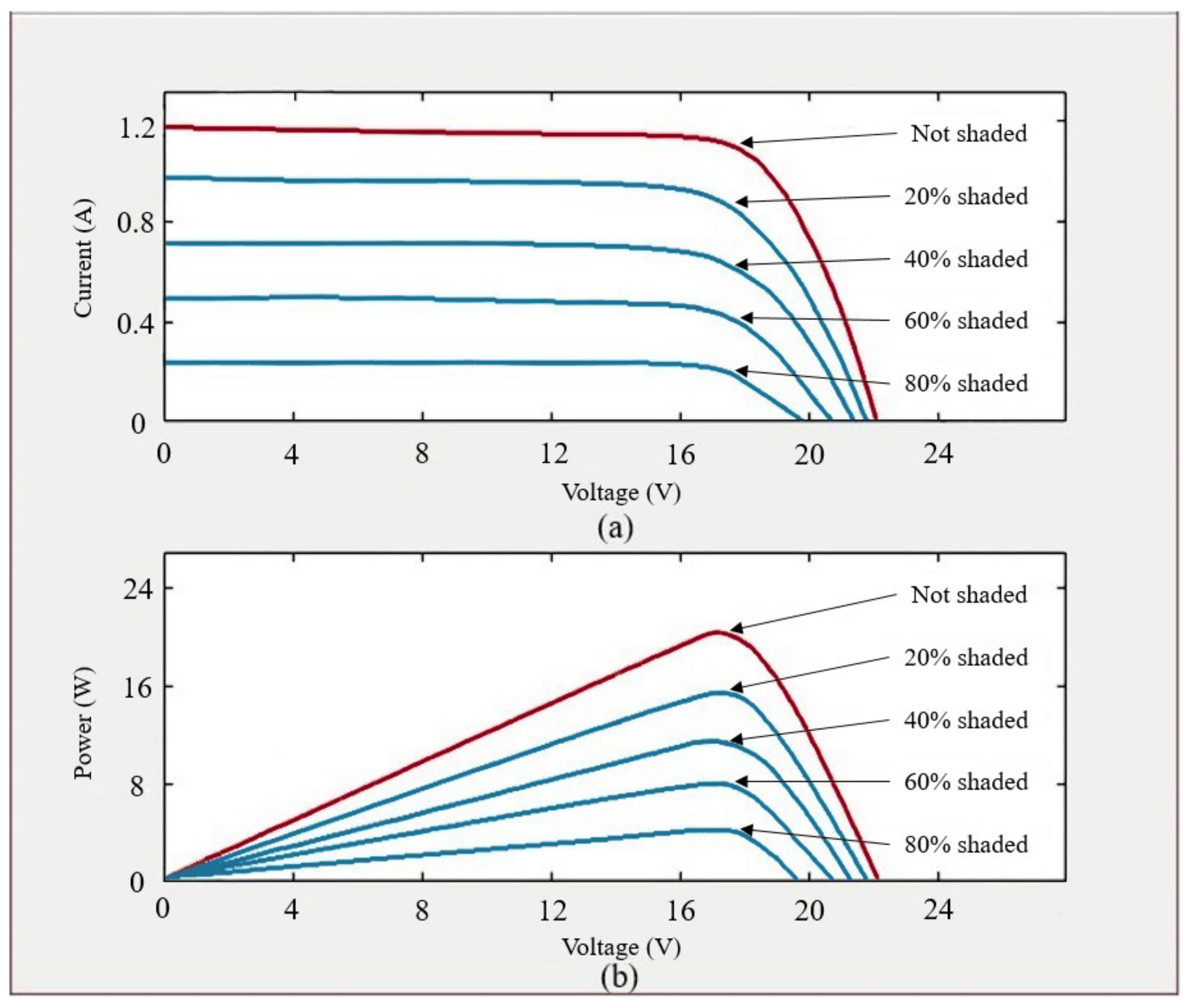
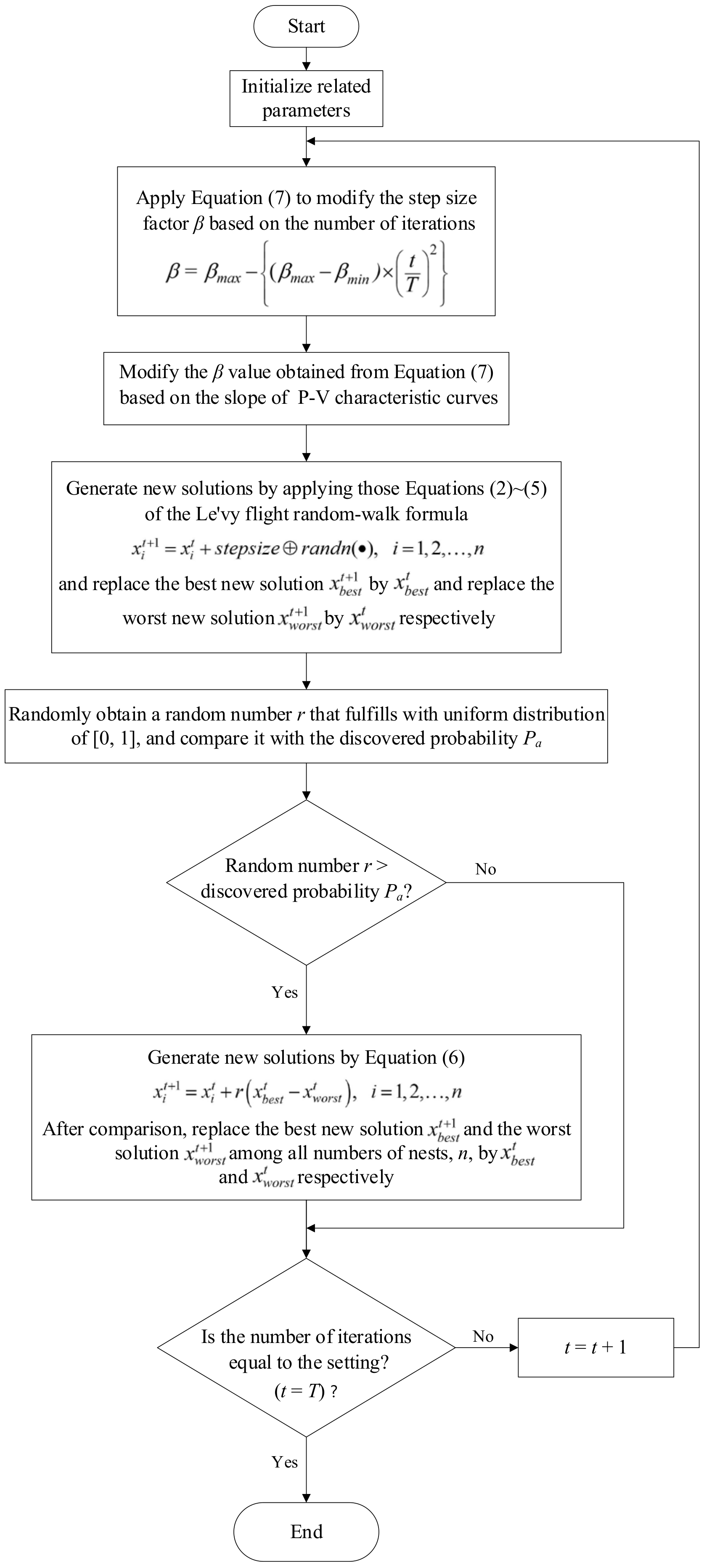
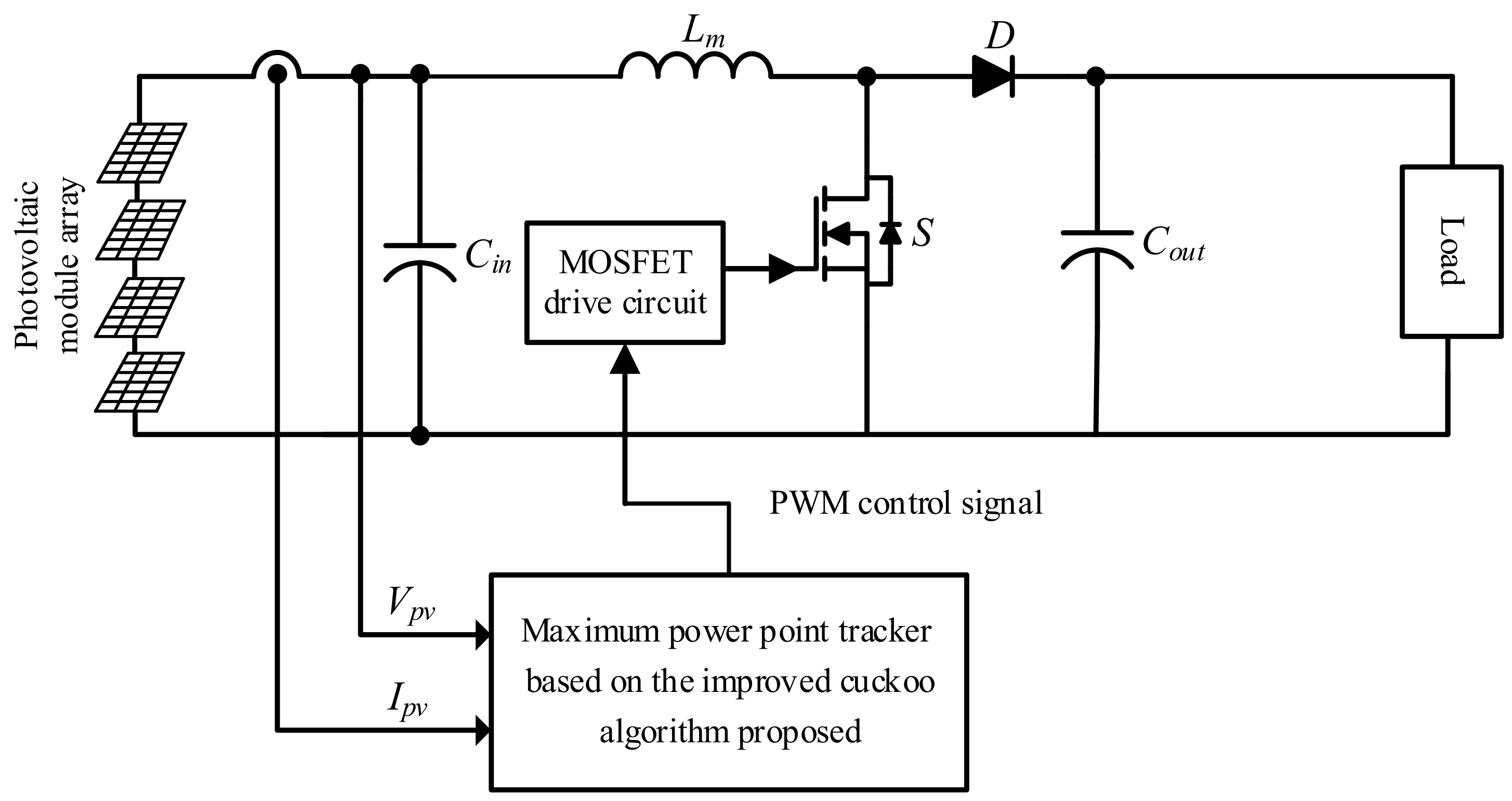

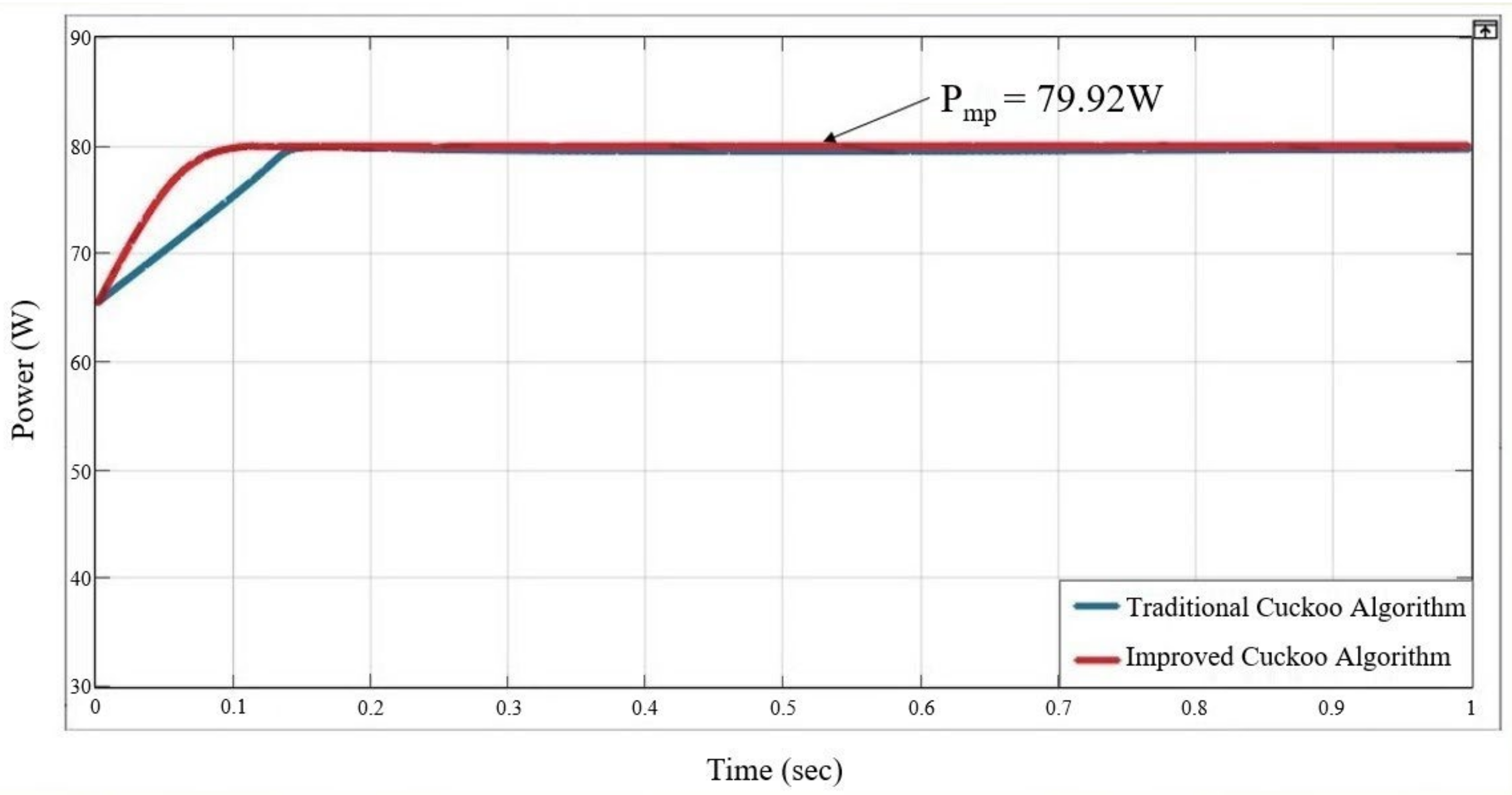
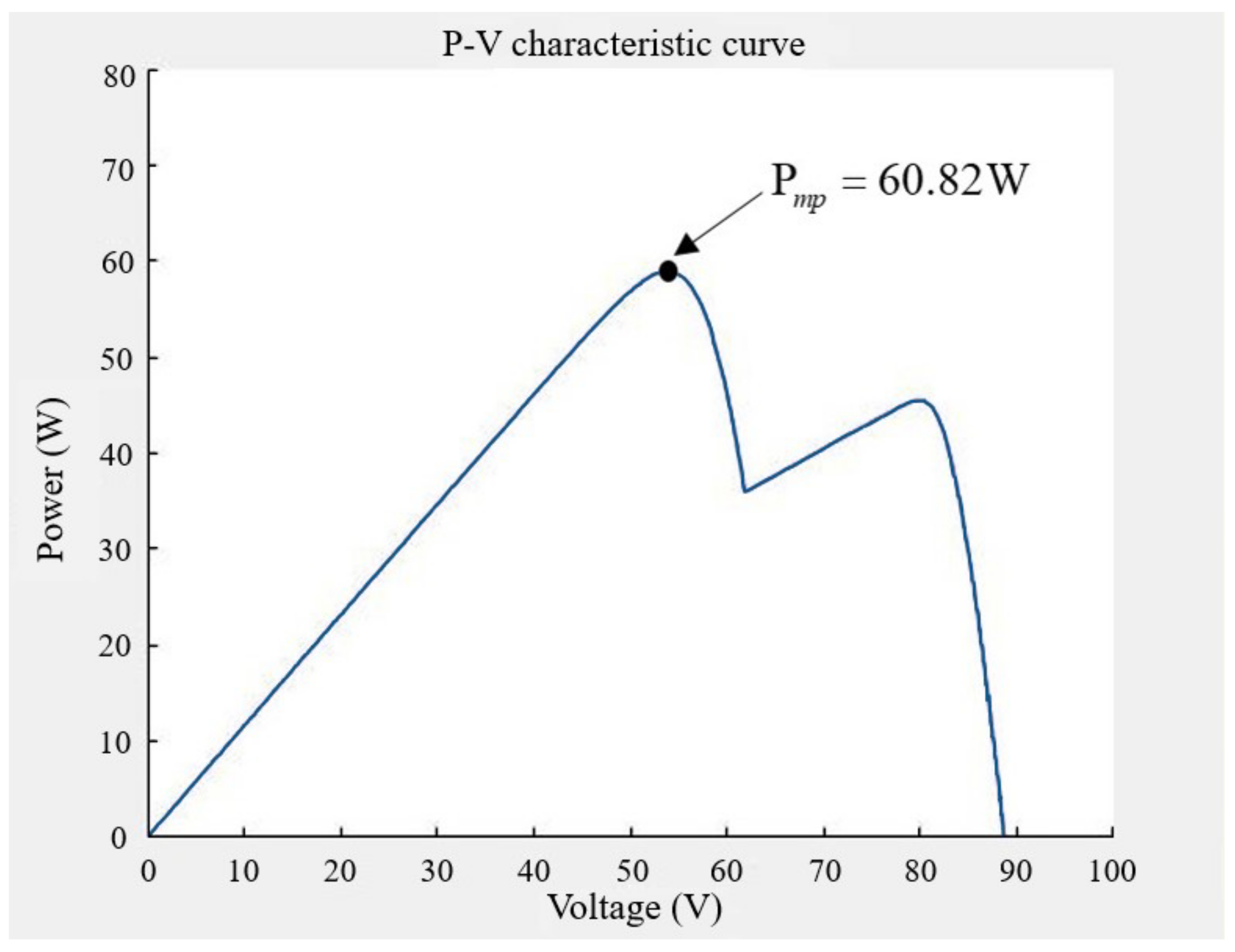
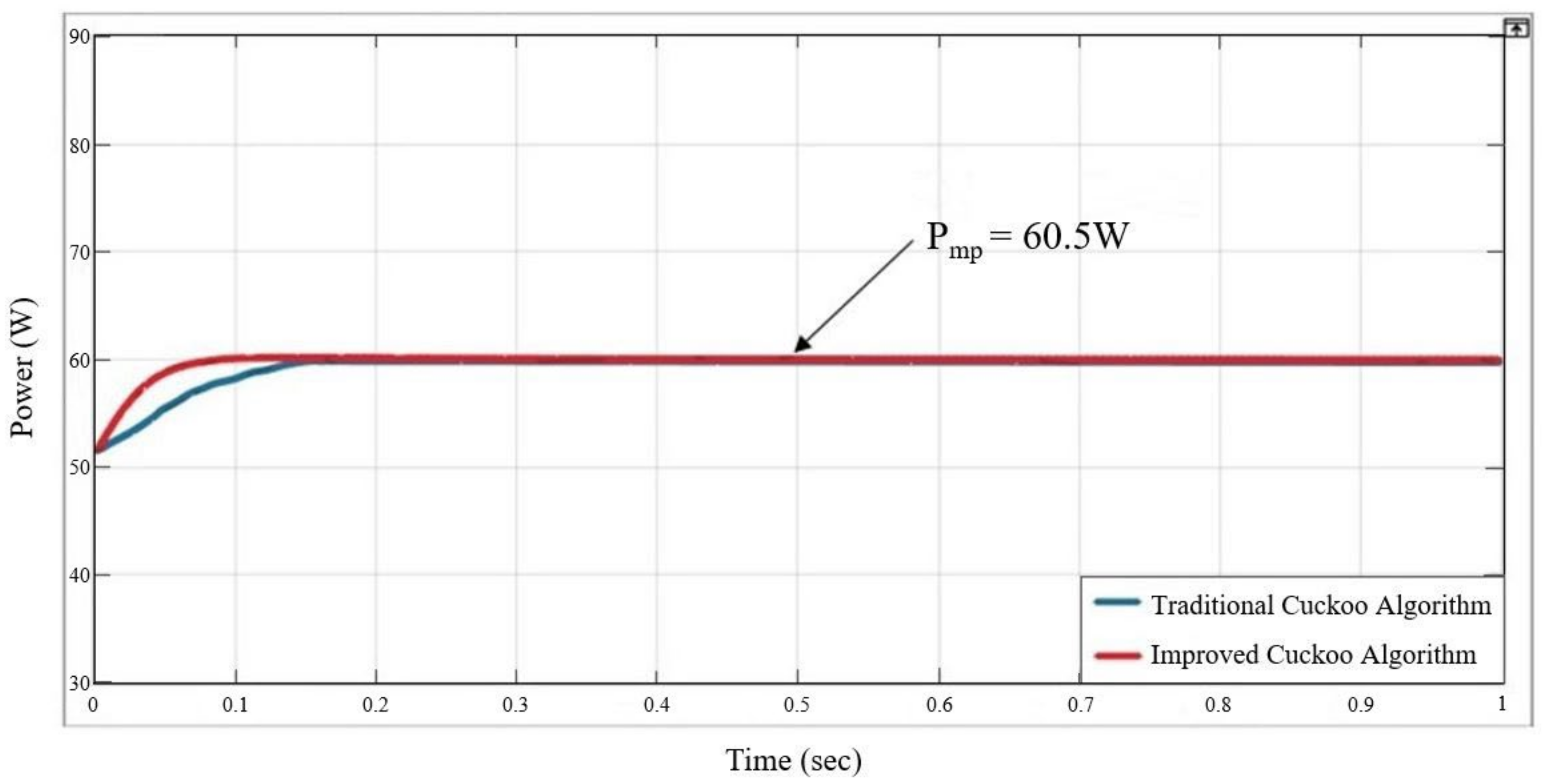
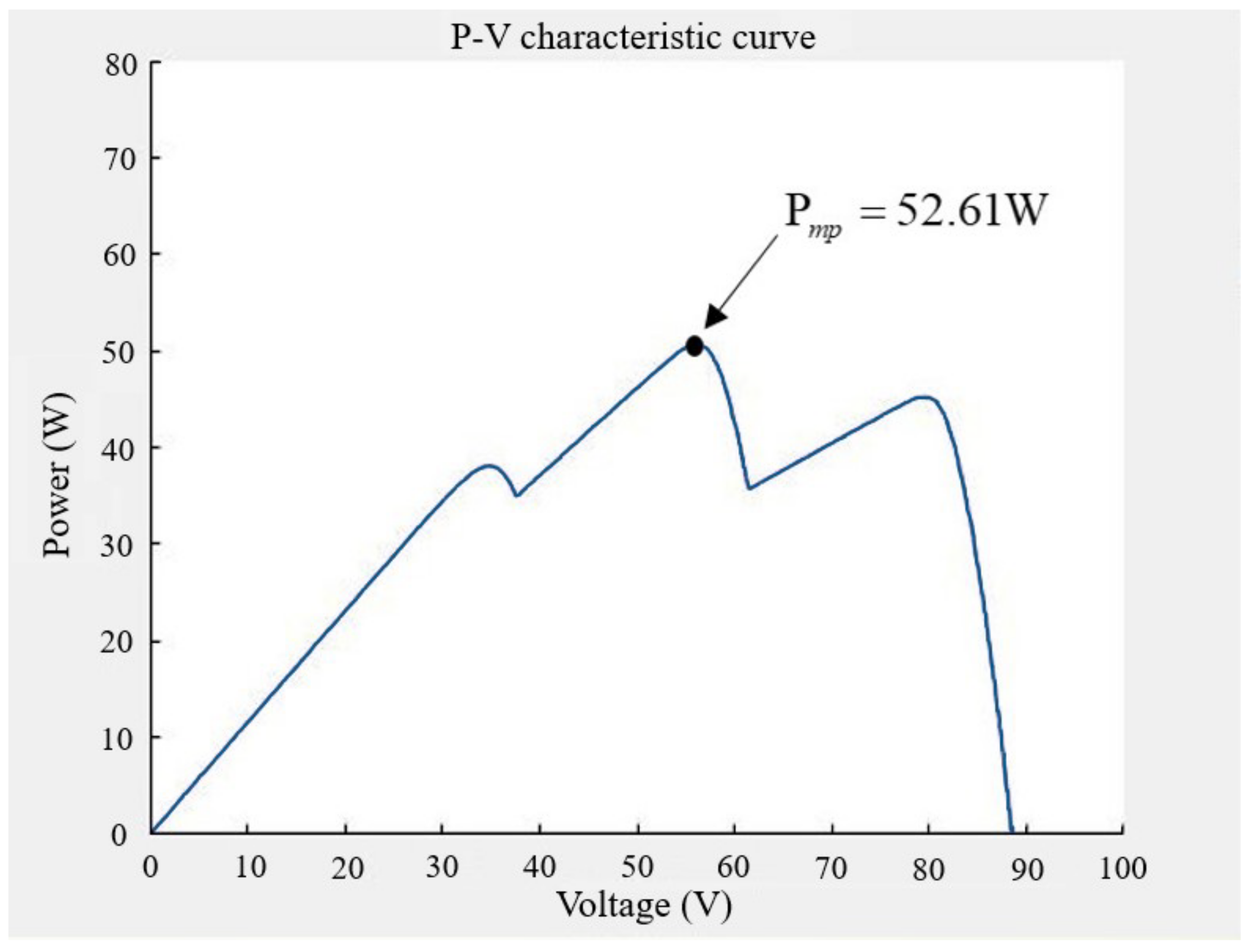
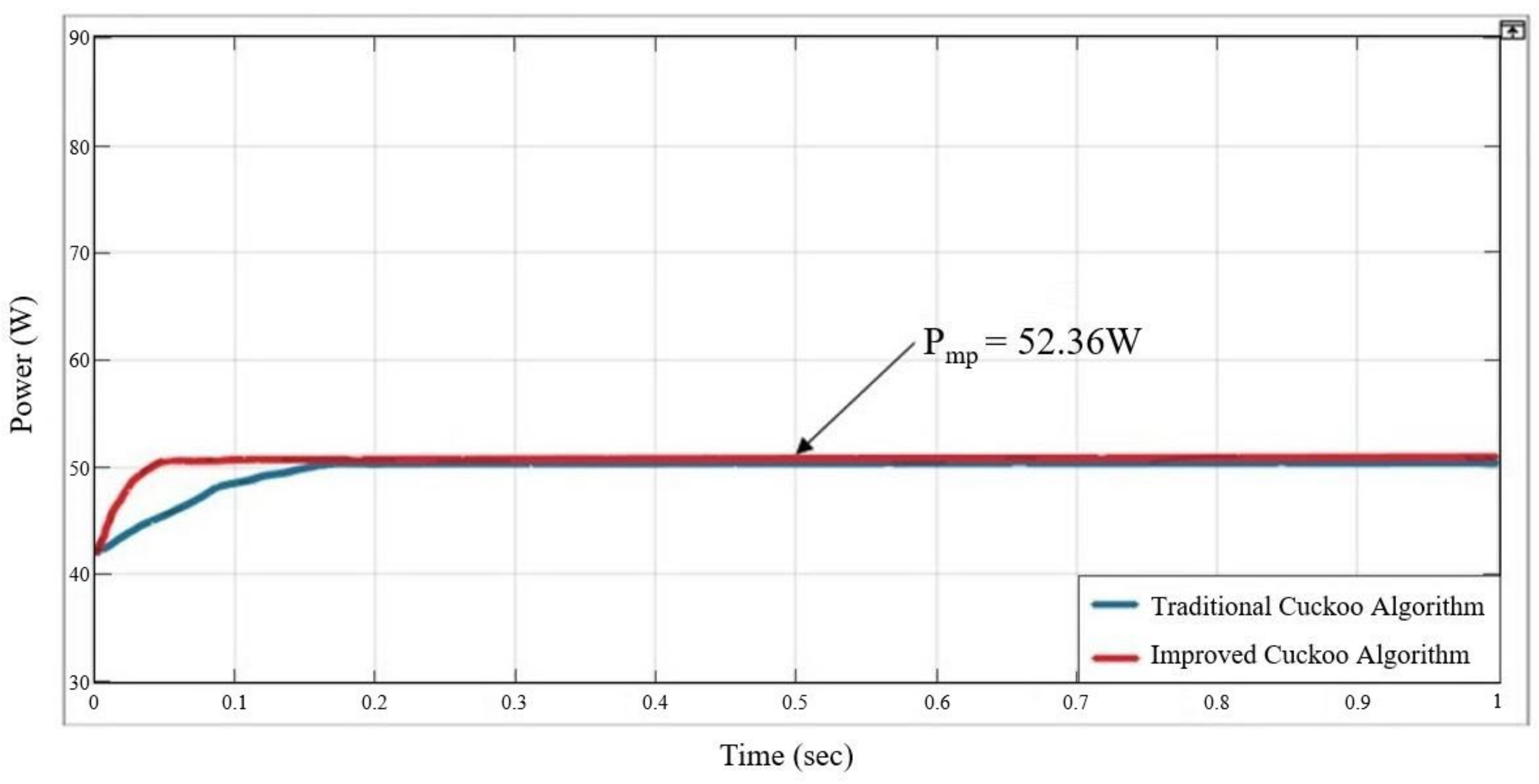


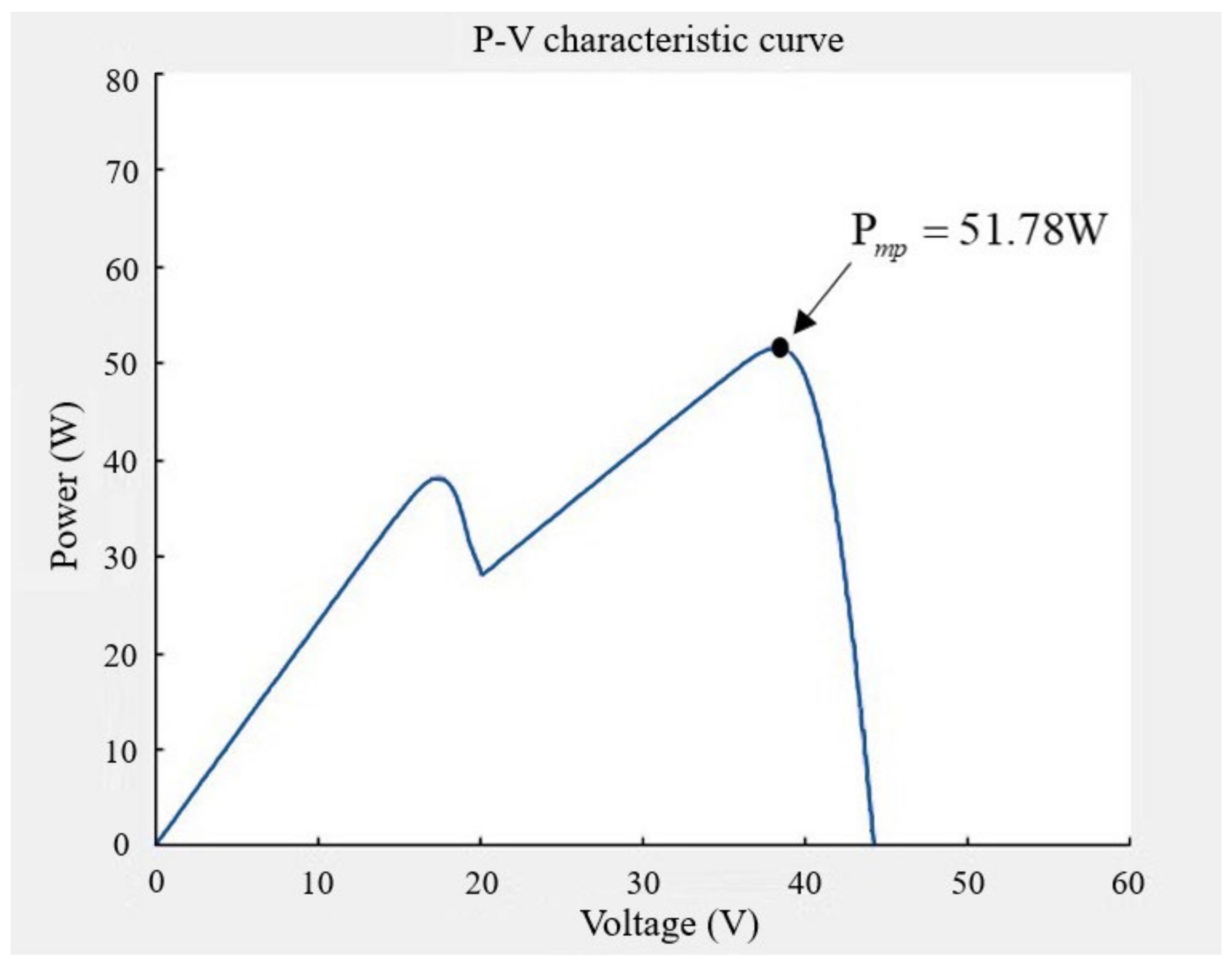



| Parameters | Specifications |
|---|---|
| Rated maximum output power (Pmp) | 20 W |
| Current at maximum output power point (Imp) | 1.1 A |
| Voltage at maximum output power point (Vmp) | 18.18 V |
| Short-circuit current (Isc) | 1.15 A |
| Open-circuit voltage (Voc) | 22.32 V |
| Length and width of module | 395 mm × 345 mm |
| Parameters | Specifications |
|---|---|
| Number of nests (n) | 25 |
| Discovered probability (Pa) | 0.25 |
| Number of iterations (T) | 50 |
| Step factor (β) | 1.5 |
| Parameter Name | Settings of Parameters |
|---|---|
| Number of nests (n) | 25 |
| Discovered probability (Pa) | 0.25 |
| Number of iterations (T) | 50 |
| Step factor (β) | 1.5 |
| Upper limit of step factor (βmax) | 1.52 |
| Lower limit of step factor (βmin) | 1.42 |
| Items | Specifications |
|---|---|
| Energy storage inductance (Lm) | 415 uH, withstand current 10 A |
| Filter capacitor (Cin) | 330 uF, withstand voltage 450 V |
| Filter capacitor (Cout) | 330 uF, withstand voltage 450 V |
| Fast diode (D) IQBD60E60A1 | VRRM withstand voltage 600 V, IFAV withstand current 60 A |
| Power semiconductor (S) MOSFET IRFP460 | VDSS withstand voltage 500 V, ID withstand current 20 A |
| Case | Series-Parallel Configuration and Shading Ratio | The Number of Peaks in the P–V Curve |
|---|---|---|
| 1 | 4 series and 1 parallel: Shaded 0% + Shaded 0% + Shaded 0% + Shaded 0% | Single-peak |
| 2 | 4 series and 1 parallel: Shaded 0% + Shaded 0% + Shaded 0% + Shaded 50% | Double-peak |
| 3 | 4 series and 1 parallel: Shaded 0% + Shaded 0% + Shaded 20% + Shaded 50% | Triple-peak |
| 4 | 4 series and 1 parallel: Shaded 0% + Shaded 20% + Shaded 40% + Shaded 50% | Quadruple-peak |
| 5 | 2 series and 2 parallels: (Shaded 30% + Shaded 0%)//(Shaded 50% + Shaded 0%) | Double-peak |
| 6 | 2 series and 2 parallels: (Shaded 50% + Shaded 0%)//(Shaded 50% + Shaded 0%) | Double-peak |
| Case | Number of Peak(s) of the P–V Curve | Method Proposed in Reference [26] | Method Proposed in Reference [27] | Conventional CSLBA | CSLBOA Proposed in This Study | ||||
|---|---|---|---|---|---|---|---|---|---|
| Average Tracking Time | Average Maximum Power | Average Tracking Time | Average Maximum Power | Average Tracking Time | Average Maximum Power | Average Tracking Time | Average Maximum Power | ||
| 1 | 1 | 1.80 s | 239 W | None * | None * | 0.19 s | 79.23 W | 0.12 s | 79.92 W |
| 2 | 2 | None * | None * | 2.25 s | 20.7 W | 0.17 s | 59.92 W | 0.10 s | 60.50 W |
| 3 | 3 | 1.40 s | 114 W | 2.50 s | 16.8 W | 0.15 s | 51.97 W | 0.07 s | 52.36 W |
| 4 | 4 | 2.61 s | 116 W | 2.61 s | 12.6 W | 0.21 s | 45.41 W | 0.16 s | 45.86 W |
| 5 | 2 | None * | None * | None * | None * | 0.12 s | 51.23 W | 0.08 s | 51.60 W |
| 6 | 2 | None * | None * | None * | None * | 0.14 s | 43.14 W | 0.10 s | 43.60 W |
Publisher’s Note: MDPI stays neutral with regard to jurisdictional claims in published maps and institutional affiliations. |
© 2022 by the authors. Licensee MDPI, Basel, Switzerland. This article is an open access article distributed under the terms and conditions of the Creative Commons Attribution (CC BY) license (https://creativecommons.org/licenses/by/4.0/).
Share and Cite
Chao, K.-H.; Chang, L.-Y.; Wang, K.-W. Global Maximum Power Point Tracking of Photovoltaic Module Arrays Based on Improved Cuckoo Search Algorithm. Electronics 2022, 11, 1247. https://doi.org/10.3390/electronics11081247
Chao K-H, Chang L-Y, Wang K-W. Global Maximum Power Point Tracking of Photovoltaic Module Arrays Based on Improved Cuckoo Search Algorithm. Electronics. 2022; 11(8):1247. https://doi.org/10.3390/electronics11081247
Chicago/Turabian StyleChao, Kuei-Hsiang, Long-Yi Chang, and Kuan-Wen Wang. 2022. "Global Maximum Power Point Tracking of Photovoltaic Module Arrays Based on Improved Cuckoo Search Algorithm" Electronics 11, no. 8: 1247. https://doi.org/10.3390/electronics11081247
APA StyleChao, K.-H., Chang, L.-Y., & Wang, K.-W. (2022). Global Maximum Power Point Tracking of Photovoltaic Module Arrays Based on Improved Cuckoo Search Algorithm. Electronics, 11(8), 1247. https://doi.org/10.3390/electronics11081247







